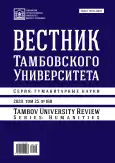Pedagogical design in teaching future bachelors of preschool education in the field of organization of artistic and aesthetic development of children
- Authors: Druzhinina A.A.1
-
Affiliations:
- Derzhavin Tambov State University
- Issue: Vol 25, No 188 (2020)
- Pages: 35-43
- Section: PEDAGOGY OF HIGHER EDUCATION
- URL: https://journal-vniispk.ru/1810-0201/article/view/298863
- DOI: https://doi.org/10.20310/1810-0201-2020-25-188-35-43
- ID: 298863
Cite item
Full Text
Abstract
We substantiate the relevance of the use of pedagogical design at different levels of education, including preschool, general, and higher education. It is noted that in order to ensure the development of future bachelors’ ability to organize the artistic and aesthetic development of preschool children, taking into account the principles of pedagogical design, it is necessary to design and implement an educational discipline for bachelors of pedagogical education, the profile “Preschool Education” – “Method of Artistic and Aesthetic Development of a Preschooler”. For this purpose, modern interpretations of the term “pedagogical design” are analyzed, and the stages of the ADDIE method of pedagogical design are studied. Pedagogical design is defined as the collaborative process of developing a course using specific learning goals and pedagogical theories to define learning strategies, activities, and assessments to achieve the desired educational outcomes. It is revealed that pedagogical design uses design principles to promote student engagement and includes the development of structures, digital learning objects, and multimedia resources to improve the quality of teaching and learning. We disclose the conceptual and analytical stage of the pedagogical design of the course “Methods of Artistic and Aesthetic Development of a Preschooler” taking into account Bloom’s taxonomy and knowledge types by L.W. Anderson and
D.R. Krathwohl. The results of the survey of students are presented. It is noted that the use of pedagogical design is a promising direction that allows building mixed learning. It is established that the effective format of interaction between the teacher and the student in the framework of mixed learning will be Face-to-face driver, when the teacher gives the main volume of the educational plan in person and uses online training as an auxiliary.
About the authors
A. A. Druzhinina
Derzhavin Tambov State University
Author for correspondence.
Email: drugininaan@yandex.ru
ORCID iD: 0000-0002-1146-0374
Anastasia A. Druzhinina, Candidate of Pedagogy, Associate Professor, Associate Professor of Theory and Methods of Preschool and Primary Education Department.
Russian Federation, 33 Internatsionalnaya St., Tambov 392000, Russian FederationReferences
- Gushchina T.I., Makarova L.N., Sharshov I.A., Kurin A.Y. Kontseptsiya razvitiya Pedagogicheskogo instituta Tambovskogo gosudarstvennogo universiteta im. G.R. Derzhavina [The concept of pedagogic institute develop-ment of Tambov State University named after G.R. Derzhavin]. Vestnik Tambovskogo universiteta. Seriya: Gumanitarnyye nauki – Tambov University Review. Series: Humanities, 2016, no. 5-6 (157-158), pp. 7-18. doi: 10.20310/1810-0201-2016-21-5/6(157/158)-7-18. (In Russian).
- Garashkina N.V., Druzhinina A.A. Sotsial’no-proyektnaya deyatel’nost’ v podgotovke bakalavrov dosh-kol’nogo obrazovaniya: razvivayushchiy potentsial i tekhnologii realizatsii [Social and project activities in the preparation of bachelors of preschool education: development potential and implementation technologies]. Sbornik statey nauchno-prakticheskoy konferentsii «Dobrovol’cheskiye initsiativy v sotsial’noy sfere» [Proceedings of the Scientific and Practical Conference “Volunteer Initiatives in the Social Sphere”]. Tambov, 2019, pp. 27-31. (In Russian).
- Akmambetova M.E., Milyayeva L.M., Romanovskaya I.A. Tekhnologicheskiy podkhod k proyektirovaniyu pedagogicheskogo dizayna v usloviyakh obrazovatel’nogo protsessa [Technological approach to projecting a pedagogical design in conditions of the educational process]. Mir nauki, kul’tury, obrazovaniya – World of Science, Culture and Education, 2019, no. 6 (79), pp. 75-77. (In Russian).
- Merrill M.D., Drake L., Lacy M.J., Pratt J. Reclaiming instructional design. Educational Technology, 1996, vol. 36, no. 5, pp. 5-7.
- Demidova I.A. Pedagogicheskiy dizayn i ego sredstva: teoreticheskiy analiz i opyt primeneniya v pedagogi-cheskoy praktike [Instructional design and its tools: theoretical study and case study]. Pedagogika. Voprosy teorii i praktiki – Pedagogy. Theory and Practice, 2019, vol. 4, no. 4, pp. 25-32. (In Russian).
- Shalashova M.M., Shevchenko N.I. Pedagogicheskiy dizayn: sushchnostnyye kharakteristiki v sisteme vys-shego obrazovaniya [Pedagogical design: essential characteristics in the higher education system]. TSITISE – CITISE, 2019, no. 5 (22), pp. 396-404. (In Russian).
- Zholdasov P. Pedagogicheskiy dizayn kak sredstvo povysheniya effektivnosti organizatsii uchebnogo protsessa [Pedagogical design as a means of improving the efficiency of organization the educational process]. Vestnik Donskogo gosudarstvennogo agrarnogo universiteta – Bulletin of Don State Agrarian University, 2019, no. S2-3 (32), pp. 32-36. (In Russian).
- Savenkov A.I., Lvova A.S., Lyubchenko O.A. Pedagogicheskiy dizayn modul’nogo postroyeniya protsessa obu-cheniya budushchikh uchiteley nachal’nykh klassov v magistrature [Pedagogical design of modular con-struction of the process of teaching future primary school teachers in the magistracy]. Sovremennyye naukoyemkiye tekhnologii – Modern High Technologies, 2018, no. 8, pp. 218-222. (In Russian).
- Bloom B.S. Taxonomy of educational objectives: The classification of educational goals: Handbook I, Cog-nitive domain. New York, McKay, 1969.
- Anderson L.W., Krathwohl D.R., Bloom B.S. A Taxonomy for Learning, Teaching, and Assessing: a Revision of Bloom’s Taxonomy of Educational Objectives. New York, Longman, 2001.
Supplementary files









